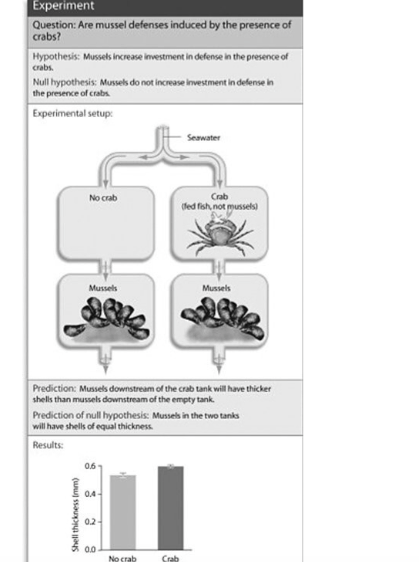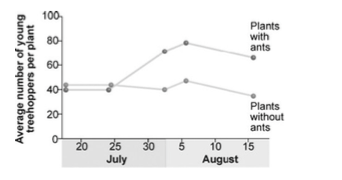Instructions for Side by Side Printing
- Print the notecards
- Fold each page in half along the solid vertical line
- Cut out the notecards by cutting along each horizontal dotted line
- Optional: Glue, tape or staple the ends of each notecard together
Ch.54
front 1 1) Some birds follow moving swarms of army ants in the tropics. As the ants march along the forest floor hunting insects and small vertebrates, birds follow and pick off any insects or small vertebrates that fly or jump out of the way of the ants. This situation is an example of what kind of species interaction between the birds and the ants? A) consumption | back 1 B) commensalism |
front 2  In the hypothesis that Chthamalus stellatus (a species of barnacle)
is competitively excluded from the lower intertidal zone by Balanus
balanoides (another species of barnacle), what could be concluded
about the two species? B) The fundamental and realized niches of B. balanoides and C.
stellatus are different. | back 2 D) The fundamental and realized niches of B. balanoides are identical, but the fundamental and realized niches of C. stellatus are different. |
front 3  What conclusion can you draw from the figure? | back 3 A) Without direct contact, mussels can sense the presence of crabs. |
front 4 As you study two closely related predatory insect species, the two-spot and the three-spot avenger beetles, you notice that each species seeks prey at dawn in areas without the other species. However, where their ranges overlap, the two-spot avenger beetle hunts at night and the three-spot hunts in the morning. When you bring them into the laboratory and isolate the two different species, you discover that the offspring of both species are found to be nocturnal. You have discovered an example of ________. A) mutualism | back 4 D) resource partitioning |
front 5  In this experiment, Balanus was removed from the habitat shown on the
left. | back 5 D) The removal of Balanus shows that competitive exclusion prevented Chthamalus from occupying the lower tide region of its fundamental niche. |
front 6  Connell conducted this experiment to learn more about ________. A)
character displacement in the color of barnacles D) competitive exclusion and distribution of barnacle species | back 6 D) competitive exclusion and distribution of barnacle species |
front 7 ) The symbols +, -, and 0 are used to show the results of interactions between individuals and groups of individuals. The symbol + denotes a positive interaction, - denotes a negative interaction, and 0 denotes interactions in which individuals are not affected. The first symbol refers to the first organism mentioned. What interactions exist between a lion pride and African wild dogs, if the dogs are found to typically avoid areas with lions? A) +/+ | back 7 B) +/- |
front 8 ) The symbols +, -, and 0 are used to show the results of interactions between individuals and groups of individuals. The symbol + denotes a positive interaction, - denotes a negative interaction, and 0 denotes interactions in which individuals are not affected. The first symbol refers to the first organism mentioned. Which fact is correct when describing species interactions? A) +/0 will always remain such. | back 8 B) A +/- interaction could shift to +/0 or +/+ over time, depending on other factors such as competition, population density, or environmental changes. |
front 9 Which of the following statements is consistent with the principle of
competitive exclusion? A) The random distribution of one competing
species will have a positive impact on the population growth of the
other competing species. C) Even a slight reproductive advantage will eventually lead to the
elimination of the less well adapted of two competing species. | back 9 C) Even a slight reproductive advantage will eventually lead to the elimination of the less well adapted of two competing species. |
front 10 If two species are close competitors, and one species is
experimentally removed from the community, the remaining species would
be expected to ________. C) become the target of specialized parasites D) expand its realized niche | back 10 D) expand its realized niche |
front 11 Which of the following is an example of a commensalism? | back 11 D) cattle egrets eating insects stirred up by grazing bison |
front 12  Treehoppers (a type of insect) produce honeydew, which ants use for food. Treehoppers have a major predator, the jumping spider. Researchers hypothesized that the ants would protect the treehoppers from the spiders. In an experiment, researchers
followed study plots with ants removed from the system and compared
them to a control plot. From the figure, what can you conclude? B) Ants eat the honeydew produced by treehoppers. | back 12 A) Ants do somehow protect the treehoppers from spiders. |
front 13  Treehoppers (a type of insect) produce honeydew, which ants use for food. Treehoppers have a major predator, the jumping spider. Researchers hypothesized that the ants would protect the treehoppers from the spiders. During a one-year study, researchers found no difference in treehopper populations in any of their control and experimental groups. What could they measure during the second year to gain information about why this might have occurred? A) Measure the number of ant females. | back 13 C) Measure the relative abundance of jumping spiders |
front 14 Resource partitioning would be most likely to occur between
________. | back 14 A) sympatric populations of species with similar ecological niches |
front 15 Character displacement differs from resource partitioning because
character displacement ________. C) is a difference in the niche within a habitat that is preferred to be used by a species D) is not the result of competition | back 15 B) is directly linked to the evolution of genotypes that have allowed alternate resource use |
front 16 Which of the following is an example of Müllerian mimicry? | back 16 A) two species of unpalatable butterfly that have the same color pattern |
front 17 Which of the following is an example of Batesian mimicry? | back 17 a nonvenomous larva of a moth that moves like a venomous snake |
front 18 Which of the following is an example of aposematic coloration? A) a
non-poisonous snake mimics the color of a poisonous one D) a katydid whose wings look like a dead leaf | back 18 B) the brightly colored patterns of monarch butterfly caterpillars |
front 19 Dwarf mistletoes are flowering plants that grow on certain forest trees. They obtain nutrients and water from the vascular tissues of the trees. The trees derive no known benefits from the dwarf mistletoes, nor are they negatively affected by this interaction. Which of the following best describes the interactions between dwarf mistletoes and trees? A) mutualism | back 19 B) commensalism |
front 20 In some circumstances, grasses that initially lose tissues from being
consumed by animals such as elk or cattle regrow more than they would
have otherwise, and benefit from the moderate levels of grazing. Which
of the following terms would best describe such a plant-herbivore
interaction? | back 20 A) mutualism |
front 21 Which of the following measurements would be most helpful in understanding the structure of an ecological community?
A) only I and II | back 21 A) only I and II |
front 22 Which of the following studies would a community ecologist undertake to learn about competitive interactions? I) II) III) selectivity of nest sites among cavity-nesting songbirds A) only I and II | back 22 D) I, II, and III |
front 23 How might an ecologist test whether a species is occupying all of its
fundamental niche or only a portion of it? C) Measure the change in reproductive success when the species is
subjected to environmental stress. | back 23 B) Observe if the species expands its range after the removal of a competitor. |
front 24 The symbols +, -, and 0 are to be used to show the results of interactions between individuals and groups of individuals. The symbol + denotes a positive interaction, - denotes a negative interaction, and 0 denotes where individuals are not affected by interacting. The first symbol refers to the first organism mentioned. What interactions exist between cellulose-digesting organisms in the gut of a termite and the termite? A) +/+ | back 24 A) +/+ |
front 25 The symbols +, -, and 0 are to be used to show the results of interactions between individuals and groups of individuals. The symbol + denotes a positive interaction, - denotes a negative interaction, and 0 denotes where individuals are not affected by interacting. The first symbol refers to the first organism mentioned. What interactions exist between mycorrhizae and evergreen tree roots? A) +/+ | back 25 A) +/+ |
front 26 Red-cheeked salamanders are partially protected from predators because of cardiac glycosides they produce from glands on their back. When ingested, cardiac glycosides disrupt normal heart rhythms. A different salamander species, the imitator salamander, also has red cheek patches, but does not produce cardiac glycosides. It does gain protection from predators that have learned to avoid red-cheeked salamanders. How does this relationship affect the population dynamics of both species? A) Both species are negatively affected. B) Both species are positively affected. C) The red-cheeked salamander is positively affected; the imitator is negatively affected. D) The red-cheeked salamander is not affected; the imitator is positively affected. | back 26 D) The red-cheeked salamander is not affected; the imitator is positively affected. |